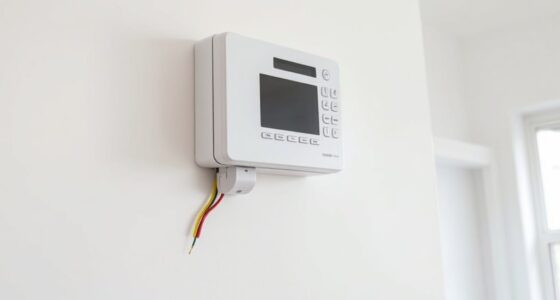For the best protection using a **home security system**, begin by checking your house for weak spots, particularly the **entry points** like doors and windows. Select the appropriate elements, such as entry sensors, motion detectors, and cameras. When it comes to **installation**, gather the required tools and adhere to the manufacturer’s instructions for placing sensors and the main control panel. Secure everything properly, and test the system to ensure it works well. Remember to carry out routine checks and maintenance to keep the system running smoothly. To learn more important tips and tricks for a strong security setup, read on. Start now to keep your home safe and secure.
Key Takeaways
- Assess your property layout to identify vulnerable entry points for sensor placement.
- Choose and install entry sensors on doors and windows, along with motion detectors for indoor monitoring.
- Follow the manufacturer's guidelines for securely mounting sensors and the main control panel.
- Test the entire security system after installation to ensure all components are functioning properly.
Assessing Your Security Needs
To effectively secure your home, you first need to evaluate your specific security needs by inspecting your property's layout and identifying potential vulnerabilities.
Start by examining all entry points, like doors and windows, as these are the most common targets for intruders. Consider the value of your assets, such as electronics and personal belongings, to determine how robust your security system should be. Additionally, ensuring your home is well-insulated can prevent unwanted access points and improve overall efficiency, similar to how enhancing heat pump efficiency can optimize energy use.
Next, analyze your neighborhood's crime rates. Understanding local crime trends can provide context for the level of security required. If your area has higher break-in rates, you might need a more thorough system.
Think about the features you want in a security system. Options like cameras, motion detectors, and environmental sensors can enhance your protection. You'll also need to decide between a DIY system, which allows for personal control and customization, or a professionally monitored service that offers 24/7 oversight and immediate response in emergencies.
Choosing the Right Components

Selecting the right components for your home security system is essential for guaranteeing thorough protection and peace of mind. Start with key devices like entry sensors for doors and windows, motion detectors for indoor spaces, and environmental sensors to detect smoke, carbon monoxide, and water leaks.
A user-friendly control panel with remote access capabilities lets you manage your system from anywhere. You should also consider integrating smart home features, such as compatibility with mobile apps and voice assistants, to enhance convenience.
For extensive coverage, include both indoor and outdoor security cameras equipped with night vision and motion detection. This guarantees effective surveillance day and night. Finally, assess the scalability of your chosen components, allowing for future upgrades as your security needs evolve.
Here's a quick overview of essential components:
| Component Type | Purpose |
|---|---|
| Entry Sensors | Secure doors and windows |
| Motion Detectors | Monitor movement within your home |
| Environmental Sensors | Detect smoke, carbon monoxide, and leaks |
| Indoor/Outdoor Cameras | Provide surveillance and monitoring |
| Control Panel | Manage your security system remotely |
Installation Preparation Steps

Before diving into the installation, take a moment to assess your property for vulnerable entry points and figure out where to place the main panel, sensors, and cameras effectively. This assessment is essential for a successful security system installation.
Start by identifying doors and windows that need door and window sensors. Additionally, consider enhancing your security with options like advanced garage door openers that feature smartphone connectivity and security alerts.
Next, gather the necessary tools and supplies, like a cordless drill, screwdriver, and double-sided tape, to guarantee a seamless process. If you're using home security kits, follow the manufacturer's guidelines for proper sensors positioning. Verify that each sensor is securely attached to the designated entry points.
Once everything's in place, it's time to test the system. Check all sensors and cameras to confirm functionality. Make any adjustments as needed to guarantee peak performance.
Installation Procedure Overview

Begin by choosing a central location for the main panel near a primary entry door and power source, making certain it's easily accessible for future adjustments. This guarantees a streamlined installation process, similar to how architectural services focus on continuous support throughout the design process.
Once you've selected the spot, use the provided installation guide to securely mount the main panel. Position your entry sensors and motion sensors according to the manufacturer's guidelines to guarantee optimal coverage throughout your home.
For door and window sensors, apply double-sided adhesive tape or screws to attach both the sensors and their corresponding magnets. It's essential to align them correctly for reliable operation.
After the installation, it's time to test the system. Arm and disarm it, and check each sensor and camera to confirm they function properly. This step is crucial before finalizing your installation.
System Testing and Maintenance

Regularly testing your home security system is vital to guarantee all components work effectively and provide the protection you need. Aim to perform system testing at least once a month. Simulate alarms to check that all sensors and cameras function correctly, ensuring you're prepared in case of an emergency.
Additionally, just as employers conduct background checks to verify candidate information, ensuring your system is robust can help identify potential risks to your home security background checks enhance safety.
For maintenance, establish a routine to check and replace batteries in wireless devices every six months. This helps prevent unexpected failures that could compromise your security. Don't overlook software updates; utilize the manufacturer's guidelines to keep your system's performance exceptional and secure from vulnerabilities.
An annual review is essential. Take the time to assess the entire system, including sensor placements and monitoring plans, to adapt to any changes in your household or environment.
Maintain a log of system tests, battery replacements, and any issues encountered. This record not only tracks performance but also makes troubleshooting much easier.
Frequently Asked Questions
Can I Install a Home Security System Myself?
Yes, you can install a home security system yourself. Many systems are designed for DIY installation, featuring user-friendly guides and minimal tools. Just follow the instructions, and you'll have it up and running in no time!
Do You Need an Electrician to Install a Security System?
You don't necessarily need an electrician to install a security system. DIY options are available, but if you choose a wired system, hiring a professional can guarantee proper installation and adherence to safety standards.
How Do I Install a Home Security System?
Installing a home security system is like building a fortress. Start by choosing a prime spot for the main panel, then position sensors and detectors wisely. Secure everything, test functionality, and maintain regularly for safety.
How Much Does It Cost to Install a New Security System?
Installing a new security system can cost between $200 and $2,000. If you choose professional installation, expect to pay $800 to $1,600. Don't forget monthly monitoring fees, which usually range from $10 to $50.
Can I Install a Free Home Security System Myself?
Yes, you can install a free home security system yourself. Many companies offer DIY security systems that are easy to set up and don’t require professional installation. With a free home security system, you can protect your home and loved ones without breaking the bank.
Conclusion
In the end, fitting a home security system isn't just about adding cameras and alarms; it's about creating peace of mind amid the chaos of daily life.
While you're busy juggling work, family, and everything in between, your security system stands guard, silently protecting what matters most.
Don't overlook the importance of regular testing and maintenance—just like life, a little attention can go a long way in keeping your home safe and secure.









